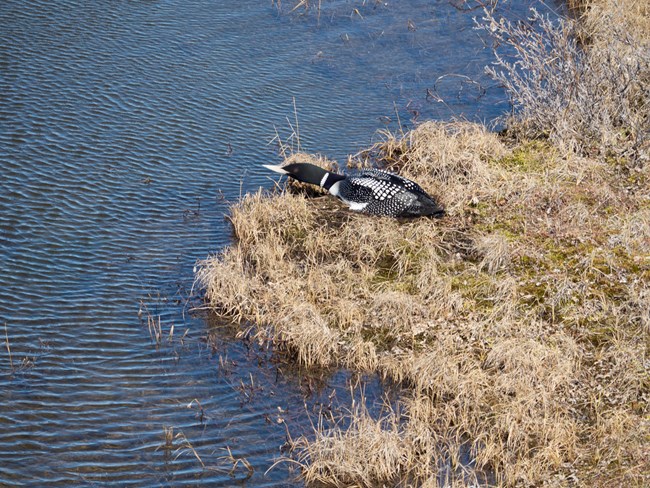
NPS/Stacia Backensto
The Yellow-billed Loon is an international species of concern considered to be one of the 10 rarest birds that regularly breed on the mainland U.S. These birds occur in a circumpolar distribution and breed in Arctic tundra habitats, including areas of Bering Land Bridge National Preserve and Cape Krusenstern National Monument. Little is known about the species’ status outside of the U.S. and Canada. The loons winter from Russia and Alaska along the coastlines of the Bering Sea and Aleutian Islands to the Yellow Sea in China. Approximately 20-25% of the global population occurs seasonally in Alaska, where the total summer breeding population is estimated at 3,700-4,900 birds. In Alaska, Yellow-billed Loons are restricted to tundra landscapes on the Arctic Coastal Plain and northwestern Alaska with large, deep, clear, freshwater, fish-bearing lakes.
Because Yellow-billed Loons are large-bodied, long-lived and return to the same breeding sites each year they are ideal for monitoring long-term trends in occupancy, density and distribution. They are indicators of water quality and provide insight into the movement of marine-derived nutrients and shifts in riparian or coastal environments. In addition, as large, long-lived, top trophic-level predators of fish in lake ecosystems, Yellow-billed Loons may bioaccumulate contaminant loads over a lifetime. This is of particular concern because some of the Yellow-billed Loons in northwestern Alaska winter in the highly contaminated Yellow Sea and the loons and their eggs are harvested for human subsistence.
We monitor Yellow-billed Loons in Bering Land Bridge National Preserve and Cape Krusenstern National Monument to document:
- Long-term trends in occupancy, density, and distribution.
- Types and levels of contaminant burdens in eggs and prey fish from nesting lakes.
Contact: Melanie Flamme
- Duration:
- 1 minute, 21 seconds
As permafrost thaws, lakes fill with water. If the water levels get too high, erosion channels can form and drain the lakes. In recent years, large lakes in Bering Land Bridge National Preserve have drained. This is of particular concern because these large lakes are important habitat for Yellow-billed Loons.
Learn more
Last updated: May 16, 2024
